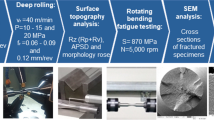Abstract
Among the several processes available for the inducement of compressive residual stresses by means of cold work hardening, deep rolling is one of the most widely used especially in the case of solid rotationally symmetrical components, such as axles and shafts. This work investigates the effect of two deep rolling parameters, namely rolling pressure and number of passes, on the surface topography, surface near residual stress, amount of retained austenite and subsurface microhardness distribution of hardened AISI 1060 steel. The results show that after deep rolling the surface topography is characterized by a plasticized zone without evidence of spalling or cracks. A 10-fold decrease in surface roughness is provided by deep rolling and an appreciable reduction was observed for the material ratio curve parameters. Compressive residual stresses were found near the surface after deep rolling and increased particularly with an increase in rolling pressure. In contrast, the highest value for the full width at half maximum was recorded under the lightest deep rolling condition. The amount of retained austenite reached its highest value when rolling with pressure of 200 bar and one pass and was associated with the thickness of the white layer. Finally, the microhardness beneath the surface increased with rolling pressure and was negatively affected by number of passes.












Similar content being viewed by others
References
Bush GF, Almen JO, Danse LA, Heiss JP (1962) How, when and by whom was mechanical prestressing discovered. In: Soc Automot Eng ISTC, Div. 20 Meeting, SAE, Colorado Springs, Colorado
Hamadache H, Laouar L, Zeghib NE, Chaoui K (2006) Characteristics of Rb40 steel superficial layer under ball and roller burnishing. J Mater Process Technol 180:130–136
Grzesik W, Żak K (2012) Modification of surface finish produced by hard turning using superfinishing and burnishing operations. J Mater Process Technol 212:315–322
El-Axir MH (2000) An investigation into roller burnishing. Int J Mach Tools Manuf 40:1603–1617
Hassan AM, Momani AMS (2000) Further improvements in some properties of shot peened components using the burnishing process. Int J Mach Tools Manuf 40:1775–1786
Loh NH, Tam SC, Miyazawa S (1993) Ball burnishing of tool steel. Precis Eng 15(2):100–105
Maximov JT, Kuzmanov TV, Duncheva GV, Ganev N (2009) Spherical motion burnishing implemented on lathes. Int J Mach Tools Manuf 49:824–831
Segawa T, Sasahara H, Tsutsumi M (2004) Development of a new tool to generate compressive residual stress within a machined surface. Int J Mach Tools Manuf 44:1215–1221
Axinte DA, Gindy N (2004) Turning assisted with deep cold rolling—a cost efficient hybrid process for workpiece surface quality enhancement. J Eng Manuf 218:807–811
Denkena D, Breidenstein B, de Leon L, Dege J (2010) Development of combined manufacturing technologies for high strength structural components. Adv Mater Res 137:219–246
Pande SS, Patel SM (1984) Investigations on vibratory burnishing process. Int J Mach Tools Des Res 24:195–206
Loh NH, Tam SC (1988) Effects of ball burnishing parameters on surface finish—a literature survey and discussion. Precis Eng 10(4):215–220
Sartkulvanich P, Altan T, Jasso F, Rodriguez C (2007) Finite element medelling of hard roller burnishing: an analysis on the effects of process parameters upon surface finish and residual stresses. J Manuf Sci Eng 129:705–716
Tekkaya AE, Kleiner M, Biermann D, Hiegemann L, Rausch S, Franzen V, Kwiatkowski L, Kersting P (2013) Friction analysis of thermally sprayed coatings finished by ball burnishing and grinding. Prod Eng Res Dev 7:601–610
Świrad S (2008) The surface texture analysis after sliding burnishing with cylindrical elements. Wear 271:576–581
Bouzid W, Tsoumarev O, Saï K (2004) An investigation of surface roughness of burnished AISI 1042 steel. Int J Adv Manuf Technol 24:120–125
Brinksmeier E, Garbrecht M, Meyer D (2008) Surface hardening by strain induced martensitic transformation. Prod Eng Res Dev 2:109–116
Morimoto T (1988) Work hardening and tool surface damage in burnishing. Wear 127:149–159
Deutsches Institut für Normung e.V. (1982) DIN 50113 Testing of metallic materials; rotating bending fatigue test (in German)
Schultze V (2006) Modern mechanical surface treatment. Wiley-VHC Verlag GmbH & Co, KGaA, Weinheim
Krauss G (1990) Steels: heat treatment and processing principles. ASM International, Materials Park
Guo YB, Sahni J (2004) A comparative study of hard turned and cylindrically ground white layers. Int J Mach Tools Manuf 44:135–145
Carroll RI, Beynon JH (2007) Rolling contact fatigue of white etching layer: part 1crack morphology. Wear 262:1253–1266
Klocke F, Bäcker V, Wegner H, Feldhaus B, Baron H-U, Hessert R (2009) Influence of process and geometry parameters on the surface layer state after roller burnishing of IN718. Prod Eng Res Dev 3:391–399
Berstein G, Fuchsbauer B (1982) Festwalzen und schwingfestigkeit. Z Werkst 13:103–109
Acknowledgments
The authors are grateful to the German Research Foundation for funding the Collaborative Research Centre 653. A.M. Abrão would like to express his gratitude to to the CAPES Foundation, Ministry of Education of Brazil, for funding his post-doctoral scholarship (Grant No. 10118128). The authors are also indebted to the Institute of Materials Science of the Leibniz Universität Hannover for the heat treatment and mechanical testing of the specimens and to both Ecoroll AG Werkzeugtechnik (Celle, Germany) and Sandvik Tooling Deutschland GmbH for the provision of deep rolling and cutting tools, respectively.
Author information
Authors and Affiliations
Corresponding author
Rights and permissions
About this article
Cite this article
Abrão, A.M., Denkena, B., Breidenstein, B. et al. Surface and subsurface alterations induced by deep rolling of hardened AISI 1060 steel. Prod. Eng. Res. Devel. 8, 551–558 (2014). https://doi.org/10.1007/s11740-014-0539-x
Received:
Accepted:
Published:
Issue Date:
DOI: https://doi.org/10.1007/s11740-014-0539-x



